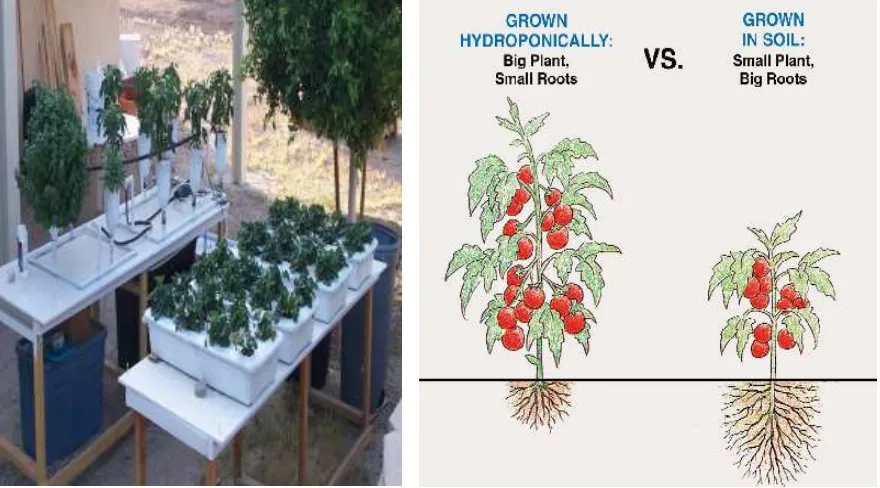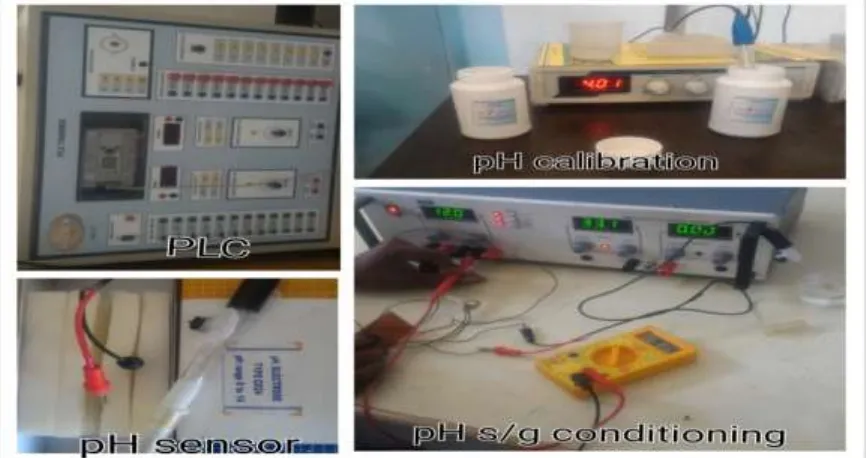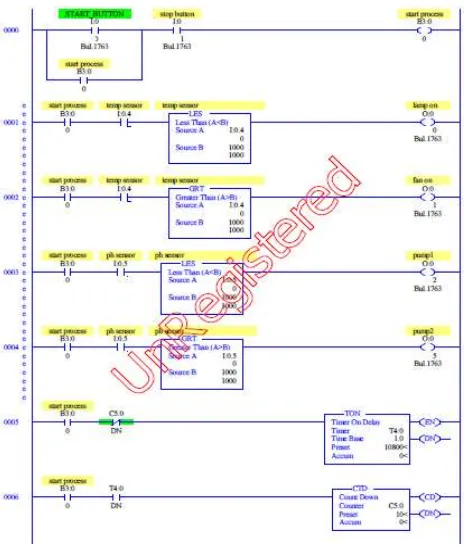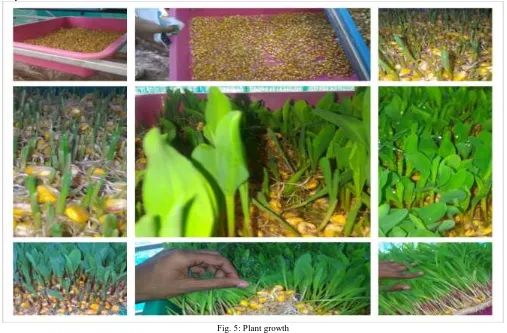PLC based Automated Hydroponic System
Prof. Nivedita Wagh Vijendra Pokharkar
Assistant Professor UG Student
Department of Instrumentation & Control Department of Instrumentation & Control Government College of Engineering & Research, Government College of Engineering & Research,
Awasari (Khurd), Tal. Ambegaon, Pune Awasari (Khurd), Tal. Ambegaon, Pune
Avinash Bastade Priyanka Surwase
UG Student UG Student
Department of Instrumentation & Control Department of Instrumentation & Control Government College of Engineering & Research, Government College of Engineering & Research,
Awasari (Khurd), Tal. Ambegaon, Pune Awasari (Khurd), Tal. Ambegaon, Pune
Umesh Borole UG Student
Department of Instrumentation & Control
Government College of Engineering & Research,Awasari (Khurd), Tal. Ambegaon, Pune
Abstract
Due to rapid urbanization and industrialization, cultivable land is decreasing rapidly. Due to rising problem of draught, shortage of water has greatly affected Agriculture. HYDROPONICS derives its name from the Greek HYDRO-PONOS meaning water/labor. Literally, "Hydroponics" means "Water Work." Hydroponic method is instrumental in cultivating a plant with minimum and recyclable water. Hydroponics is a technique of growing a plant in water with mineral nutrient solution mixed with it in soil less culture with continuous supply of oxygen at room temperature with indirect light. System uses less water and fertilizer as compared to soil system. Hydroponics has no part in the human work of plowing, hoeing and weeding the field activities of open field system. The growth rate and quality of plant are enhanced as roots gets nutrients and oxygen directly from water medium through process of diffusion. The measured and monitored parameters are pH, humidity, electrical conductivity of water and concentration of nutrients in water and these are useful for the design and development of controller and controlled automation hydroponic system in order to maintain the optimum plant growth.
Keywords: hydroponics, nutrient solution, PLC, pH, soil-less farming
________________________________________________________________________________________________________
I. INTRODUCTION
Hydroponics was practiced many centuries ago in Amazon, Babylon, Egypt, china and India where ancient men used dissolved manure to grow cucumber, watermelons and other vegetables in sandy riverbeds. The “hanging harden of Babylon” and the Aztec’s floating farms were actually prototypes of hydroponic systems. Later, when plant physiologists started to grow plants with specific nutrients for experimental purposes, they gave the name “nutriculture.” Interest in practical application of “nutriculture” developed in 1925 when the green house industry expressed interest in its use. Green house soils had to be replaced frequently to overcome problems of soil structure, fertility and pests. As a result, researchers became interested in the potential use of nutriculture to replace conventional soil culture.
In 1929, Dr. William F. Gericke of the University of California succeeded in growing tomato vines of 7.5 m height in nutrient solutions. He named this new production system “hydroponics” a word derived from Greek to reflect the importance of ‘Hydros’ (water) and ‘Ponos’ (working). Thus, hydroponics broke the laboratory bounds and entered the world of practical horticulture. The term hydroponics originally meant nutrient solution culture. However, crop growing in inert solid media using nutrient solution is also included in hydroponics in broad sense.
II. HYDROPONICS/ SOIL-LESS CULTURE-WHAT IT IS?
Hydroponics or soil-less culture is a technology for growing plants in nutrient solutions that supply all nutrient elements needed for optimum plant growth with or without the use of an inert medium such as gravel, vermiculite, rockwool, peat moss, saw dust, coir dust, coconut fibre, etc. to provide mechanical support.
advantages consist of less disease risk to the plant culture, the lack of insects and other organisms damaging the plants as well as an easier harvest period. Without the damage from insects and other pests the plants will not need to be influenced by pesticides and other harmful chemicals. In figure below you can also see how close plants can be grown to one another using hydroponics.
Fig. 1: Basic Module of typical Hydroponic & Comparison of Hydroponic vs Soil roots III. BASIC REQUIREMENTS OF HYDROPONICS
Soils naturally maintain the temperature and aeration needed for root growth. When the soil is poor, plant growth and yield decline also due to unsuitable aeration and temperature. Plant cultivation is impossible under ill drained condition due to these conditions. Soil adjusts itself to provide suitable conditions for plant growth. It is called the buffer action of the soils. Plants also absorb nutrients released through natural mineralization. In a solution or inert medium,maintenance of acidity or alkalinity (pH) and electrical conductivity (Ec) in suitable ranges for plant root system is called buffer action. This requirement must be artificially maintained in hydroponics. In any hydroponics system the following basic requirements must be maintained at optimum levels.
- Buffer action of water or the inert medium used.
- The nutrient solution or the fertilizer mixture used must contain all micro and macro elements necessary for plant growth and development.
- Buffer action of the nutrient solution must be in the suitable range so that plant root system or the inert medium is not affected.
- The temperature and aeration of the inert medium or the nutrient solution is suitable for plant root system.
IV. BLOCK DIAGRAM
Fig. 2: Block diagram of automated hydroponic farming
will have the ability to drain and refill the hydroponic system’s water if needed for various reasons which will require a water pump and a valve that can be opened to drain the water out of the reservoir. Another, the Temperature sensor will sense the system’s temperature and give it to PLC, accordingly it will operate the bulb and fan which will maintain the system’s temperature . This is a very basic outline of the hardware required.
V. AUTOMATED HYDROPONIC SYSTEM
In Automated hydroponic system plants are placed in a growing medium and nutrients are delivered directly to theroots on the basis of time. PLC is the main part of automated hydroponic system. Programmablelogic controller is used for the parameter control. The Real-time Clock component in PLC is use to set timer for nutrient pump. Timers are set daily. When timer is activated, Relay will be activated and nutrient pump will deliver Nutrient solution for time to time. When timer is deactivated the relay will be off and nutrient pump will stop to supply morenutrients in to water.
Fig. 4: PLC ladder diagram for automated hydroponic system
Plant needs five things: nutrients, water, light, air and support. We can provide all five in aautomated hydroponic system. We saw that Hydroponics plant grows well with less use of water and fertilizers. Growth rate of hydroponics plant is 40-50 fasterthan the soil system.
Fig. 5: Plant growth
In the above figure 5 the day by day growth of plant in automated hydroponic system is shown.
VII. CONCLUSION
This paper shows how automatic hydroponic system can be implemented using electronic circuit. It describes how the mixture of water and nutrient solution is automatically delivered to the roots of plants. System automatically supplies nutrient into Water every day and regularly re-circulate mixture of water and solution form reservoir. System uses less water and fertilizer as compared to soil system.
ACKNOWLEDGEMENT
We would also like to thank our project guide Mr. DhaneshPadwalsir of KRISHI VIGYAN KENDRA,Narayangaonfor his valuable guidance and continuous encouragement during the whole project. We would like to give my sincere gratitude to Mr. RanjitSir of VIGYAN ASHRAM, PABALfor his valuable guidance and given the maximum information of our project.
REFERENCES
[1] HYDROPONICS, Department of Agriculture.
[2] Ellis, N.K., Jensen, M., Larsen, J. and Oebker, N., ―Nutriculture Systems—Growing Plants Without Soil‖. Station Bulletin No. 44. Purdue University,
Lafayette, Indiana.( 1974)
[3] A REVIEW ON PLANT WITHOUT SOIL – HYDROPONICS,Mamta D. Sardare, Shraddha V. Admane
[4] Yang Chenzhong, Huang Yinchun, ZhengWeihong, “Research of hydroponics nutrient solution control technology”, 5" World Congress on Intelligent Control



